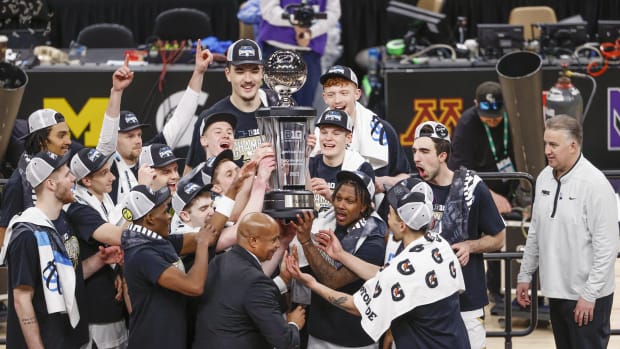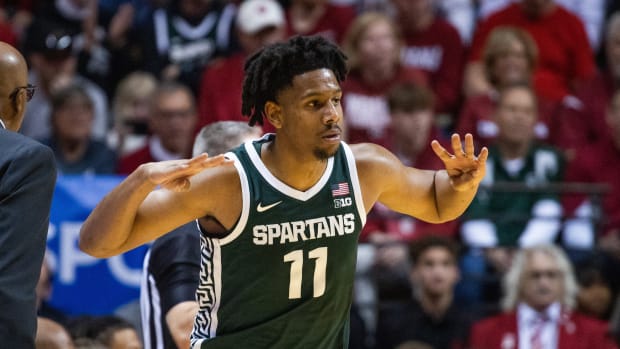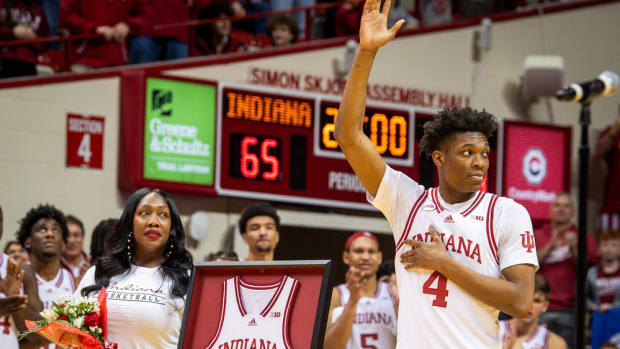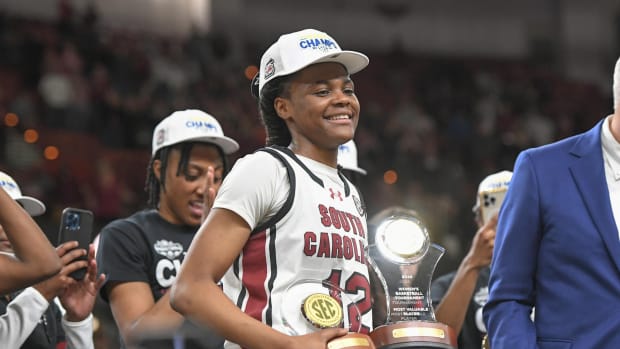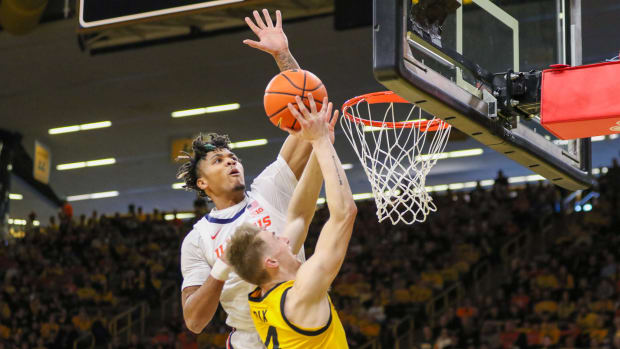Chasing 30: Can Chris Clemons Join Scoring Royalty in His Last Ride at Campbell?
To label it an experiment would have been a glaring omission of intent—the Boston Celtics, of course, were in the business of gathering information—but there was something unorthodox about the group of players working out at their Waltham, Mass., facility in the spring of 2017. If nothing, it was a study in contrast. On one end of the gym were two behemoths: 7’1” 300-pound Michael Ojo from Florida State, dwarfed by Central Florida’s 7’6”, 290-pound Tacko Fall. On the other basket, college basketball’s top two scorers from the previous season stood together for the first time, eye-to-eye at 5’9”.
You have reached your limit of 4 premium articles
Register your email to get 1 more
Marcus Keene was fresh off the highest-scoring college season in two decades, averaging 29.97 points per game at Central Michigan on his way to turning pro. Some media outlets rounded up to 30, some didn’t, but his chase for 30 had become something of a national story, albeit one without an easy resolution. Alongside him was Chris Clemons, star of the Campbell Fighting Camels, who came in behind him at 25.1 per game as a 19-year-old sophomore. His team had fallen a win short of the NCAA tournament, and his scoring prowess had gone largely unheralded, but the well-trained eyes of Denver and Boston took notice, earning Clemons his first pair of pro workouts, and an opportunity to gain feedback before returning to school.
The two scorers were similarly sized, but went about their craft in different ways. Keene functioned almost exclusively in isolation and pick and roll, enjoying unprecedented personal success on a team that needed every bucket. Clemons’s approach was a bit more measured, as he found his spots in Campbell’s Princeton-style system, breaking from it primarily when the clock ran down and his team needed a bucket. His build was more muscular, his 40-inch plus vertical more explosive, and his long-term chance to launch an NBA career was perhaps more feasible. Clemons aimed to maximize his skill set over the next two years, and knew there was no better person to takes notes from than the one next to him.
WOO: Ja Morant Is No Longer College Hoops's Best-Kept Secret
After trading layups and threes (and of course feeding their much large counterparts in the post), the two guards stopped to chat. Clemons, they agreed, had the ability to do what Keene had done. “You gotta be locked in and focused on the task of helping your team win and scoring the ball, because every night, teams are keying on you, their gameplan is to stop you,” says Keene, now a member of the NBA G League’s Memphis Hustle. Clemons asked about attacking coverages, dealing with junk defenses, and how Keene managed to stay aggressive night to night over the course of the season. Assassins rarely share their secrets, but the mutual respect was immediate. “You see a guy like that, that [plays] so close to your game, you want to learn everything you can,” Clemons says. “Picking his brain, trying to see how things were going to play out for me, trying to foreshadow that.”
If Keene’s attempt was any indicator, this will not be an easy chase. His season ended with 41 points in a conference tournament loss. The made basket that would have tipped the scales came from behind the backboard and was waved off. (I feel like that’s just good karma,” he says now.) These matters can get granular, and Clemons has ground still to make up. Entering Thursday, he led the nation with an average of 29.2 points per game, fresh off a 29-point showing and game-winning three against Charleston Southern, which put the Fighting Camels at 10–8 (3–1 in the Big South). He poured in 45 against Georgetown in November, had 44 against UNC-Wilmington in the season opener, and has scored no fewer than 19 in an outing.
Clemons’s senior-year tour de force has given him a chance at another bit of rare territory: he is sitting on 2,757 career points, and is on pace to eclipse 3,000, which would put him among the top 10 college scorers of all time. (Across the country, South Dakota State’s Mike Daum, with 2,740 career points, has a chance to do the same.) For an under-recruited, under-sized guard from Raleigh, sometimes these things still come as a surprise.
“Not to say I didn't think I was capable, but I didn’t think it was actually going to be a reality for me,” Clemons says, tucked away inside Campbell’s Pope Convocation Center after a December win against D-II Central Pennsylvania. “[Even] scoring 2,500, that’s huge. Think of all the players who have come through the NCAA.”
Although Clemons has tried to keep the noise out of earshot (“It’s just added pressure,” he explains), becoming the first player in more than 20 years to average over 30 (Keene’s decimal-point miss notwithstanding) would further rarify his air. The most prolific per-game scorer in Division I history is Pete Maravich, and it’s not particularly close: in three seasons at LSU from 1968–70, the Pistol averaged 43.8, 44.2, and then 44.5 points. But since the three-pointer was standardized by the NCAA in 1986, only 10 players have averaged north of 30. They include U.S. International’s Kevin Bradshaw, who did it twice and became the modern-era leader with a 37.6-point average in 1990-91, Bradley’s Hersey Hawkins (36.2, ’88), and Loyola Marymount teammates Hank Gathers (32.7, ’89) and Bo Kimble (35.3, ’90). Gathers might have made them the first set of 30-point scoring teammates in ‘90, but for the fatal heart condition that led to his on-court collapse and subsequent death.
“I just want [Chris] to play really well,” Campbell coach Kevin McGeehan says. Largely nonplussed by the prospect of records, McGeehan remains well aware of what he’s watching. “It’s obvious he’s a great scorer. It’s going to get harder as the year goes along…it’s not going to be easy to do. But if it ends up happening…” He pauses. “I’d be much happier if we’re playing really good basketball and Chris is leading us regardless. He’s proven he can score it.”
Watching Clemons go to work in person has become one of the more unique viewing experiences in college basketball: he’ll sink NBA threes late in the shot clock, rise to dunk backdoor alley-oops, and drop off surprising assists in the paint. You won’t hear cheers of “Pour it on Camels” anywhere but Buies Creek, N.C., nor will you see another player in the country consistently converting his free throws from an extra foot behind the line and somewhere wide right of center, like a placekicker trying to account for wayward gusts. “I thought I was missing to the left and hard, so I just moved over there somewhere,” Clemons explains. “Some people look at it weird, like, what the? Especially at away games. It’s been working out for me.”
“It’s hard to argue with a guy shooting 85, 90% from the line,” McGeehan adds, laughing. “He’s improved every year of his college career, whether that be efficiency or numbers or leadership, whatever it might be, he’s always tried to work on whatever it is we’re trying to get better at.”
Campbell’s staff discovered Clemons, a product of Millbrook High School in Raleigh, playing AAU the summer before his senior year. As other schools saw his size and looked elsewhere, McGeehan (who had success coaching small guards as an assistant at Richmond) and his staff made him the focal point of their efforts. “He plays hard and has had the ball in his hands his entire life. You‘d rather have that than, you know, a 6’2” combo that you’re trying to convince to be a point guard,” McGeehan says. Clemons committed before his senior year, and although Duke took notice after he gave Brandon Ingram’s Kinston team 37 points in a holiday tournament, he never wavered. “I felt like they should have seen it by then,” he says.
Shortly after landing on campus, Clemons proved a natural fit for Campbell’s offense, which focuses on passing, cutting and screening. “I was able to mold myself into the system pretty easily,” he says. The coaching staff tracks passing totals in every game and practice, emphasizing sharing the ball and forcing opponents to focus for the entire shot clock. His speed and skill set allows them to play in transition more than they would otherwise. If all else fails, they get the ball back to him and let him create. “We’ve sort of evolved over time with that concept,” says McGeehan. It’s a simpler task to try and limit Clemons in isolation or off a high ball screen, but as he darts around the floor drawing attention and creating space for others, it makes the Camels rather difficult to defend on the whole.
Professional scouts have seen Clemons’s brick-like frame, the diversity of his offensive impact and a prolific four-year body of work, and wonder if he might have a chance to stick, in the vein of Nate Robinson before him. His all-around growth, with an eye toward long-term development, has come in concert with that of his team. “You gotta learn how to play off the ball, do some different stuff, and when you have it you gotta be efficient with it. Take care of the ball, make plays when you can,” Clemons says. “I’m out there constantly focused on how I’m affecting the game.” Campbell’s first NCAA tournament berth since 1992 will have to come by way of a tourney championship in the one-bid Big South, and Clemons has worked to sharpen his playmaking and defense—the things that aren’t scoring.
Though Clemons will insist his mind has been elsewhere, and his standard level of calm is convincing, with at least 13 games left in his career—depending on how long the Camels’ postseason run goes—his shot at averaging 30 remains real. He will need to average just above that number the rest of the way, which is likely to require an uptick in his three-point shooting (34.9% on nearly 11 attempts per game), which will also be a function of his teammates helping find him. Campbell’s ultimate goal is reaching the Big Dance for the first time with Clemons, and maximizing his efficiency is part of that equation.
“When you start thinking about stuff like that, it's a huge pressure to go out there and try to force up shots,” Clemons says. “People talk about it, but I’m trying to just play the game.”
For the next couple months, at minimum, he’ll remain well worth the watch.


